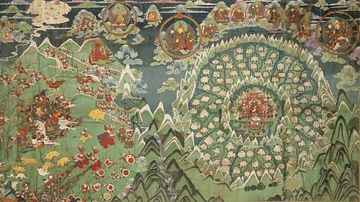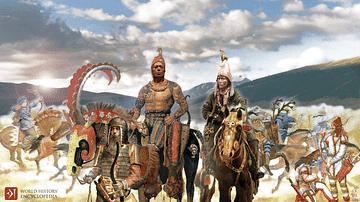Search
Search Results

Image
Kingdom of Shambhala
Kingdom of Shambhala and the Final Battle; Mongolia; 19th century; pigments on cotton; 44 x 87 1/2 in. (111.8 x 222.3 cm); Musée des arts asiatiques – Guimet, Paris; MG24416 (HAR 31352); photograph by Thierry Ollivier © RMN-Grand Palais/Art...

Image
Stone Turtle, Karakorum
A stone turtle at Karakorum, Mongolia, from the khan's palace there. The city was made capital of the Mongol Empire in 1235 CE by Ogedei Khan (r. 1229-1242 CE).

Image
Traditionally Pressed Mongol Curd
Stones being used to press curd in Khovsgol Province, Mongolia.

Video
Why Were the Mongols So Successful?
Why were the Mongols so successful? Mongol military history and battle tactics. Support new videos and join the horde on Patreon! :D I draw, edit, research, narrate and write every episode...all help is much appreciated https://www.patreon.com/Epimetheus1776...

Video
History of the Scythians: an Ancient Nomadic Culture
The Scythians were a nomadic culture that flourished between the seventh and the third centuries BCE, as their territory expanded from Thrace in the west across the Central Asian Steppe (a steppe is basically just an open swathe of grassland...

Definition
Abbasid Dynasty
The Abbasids were an Arabic dynasty that initially ruled over most of the Islamic empire (save some western parts) after assuming the caliphate in 750 CE, later on, their empire fragmented, however, they retained spiritual supremacy as caliphs...

Definition
Scythians
The Scythians were a nomadic people whose culture flourished between the 7th and 3rd century BCE in a territory ranging from Thrace in the west, across the steppe of Central Asia, to the Altai Mountains of Mongolia in the east. This covers...

Definition
Huns
The Huns were a nomadic tribe prominent in the 4th and 5th century whose origin is unknown but, most likely, they came from "somewhere between the eastern edge of the Altai Mountains and the Caspian Sea, roughly modern Kazakhstan" (Kelly...

Definition
Ancient Korea
Korea, located on a large peninsula on the eastern coast of the Asian mainland, has been inhabited since Neolithic times. The first recognisable political state was Gojoseon in the second half of the first millennium BCE. From the 1st century...

Definition
Chinese Writing
Ancient Chinese writing evolved from the practice of divination during the Shang Dynasty (1600-1046 BCE). Some theories suggest that images and markings on pottery shards found at Ban Po Village are evidence of an early writing system but...